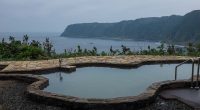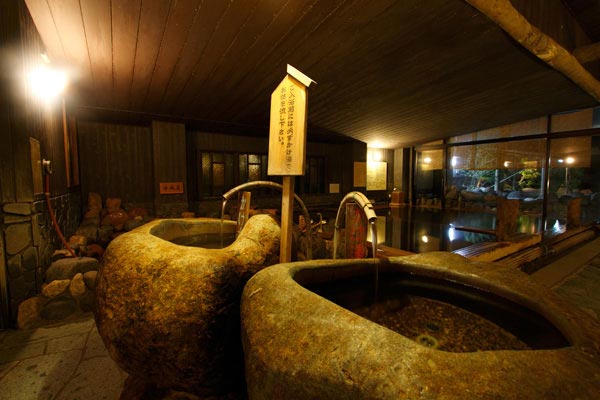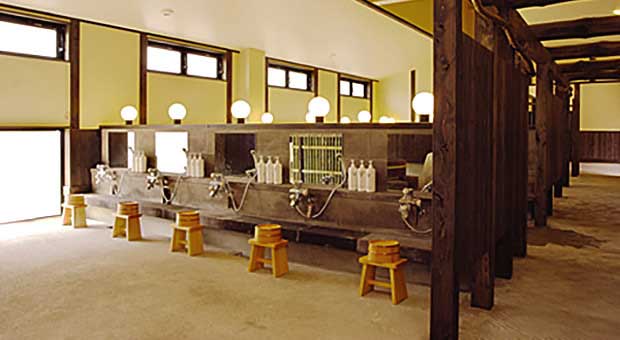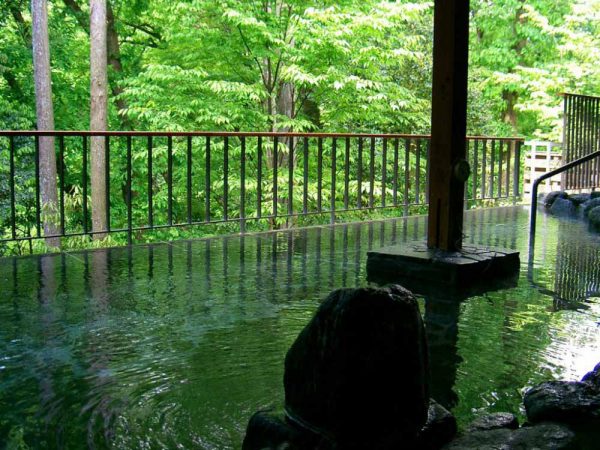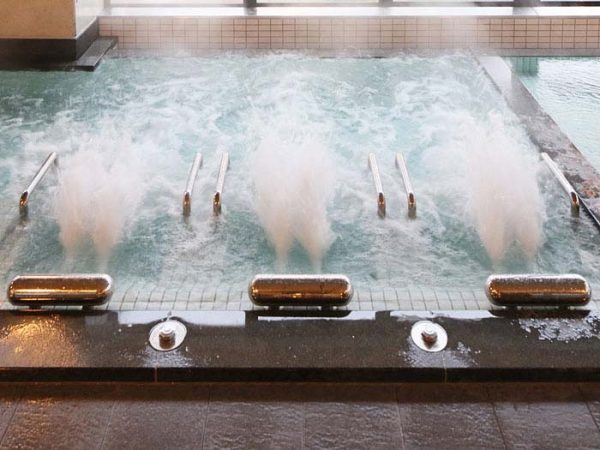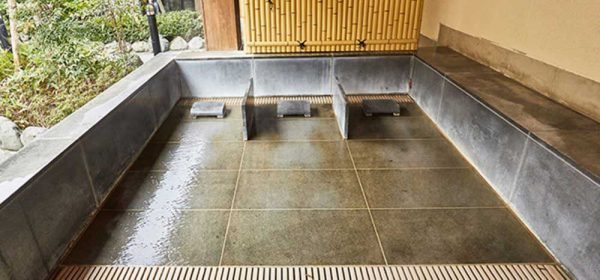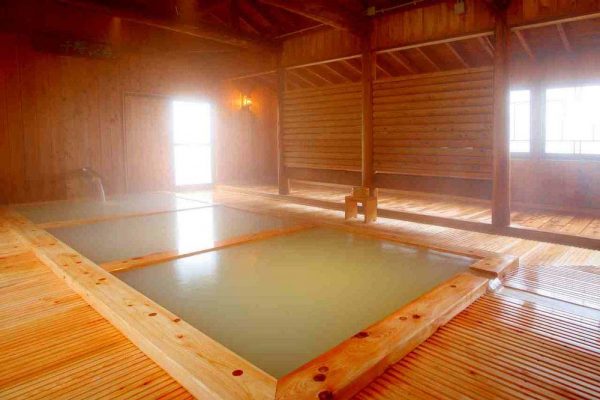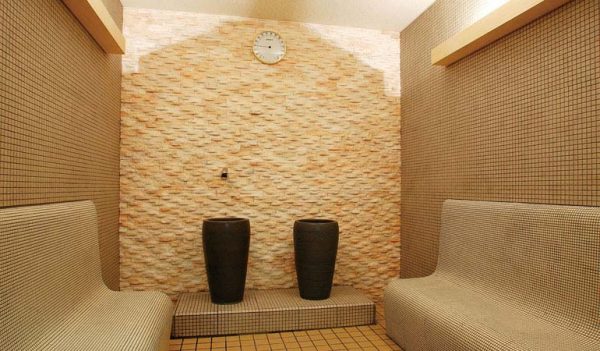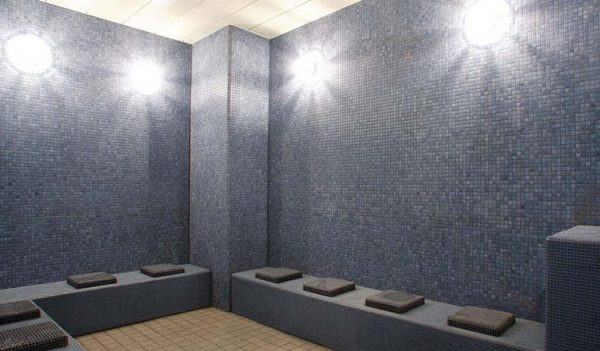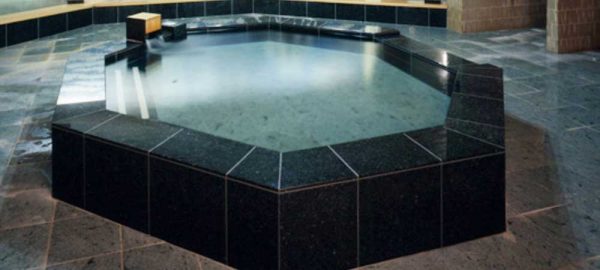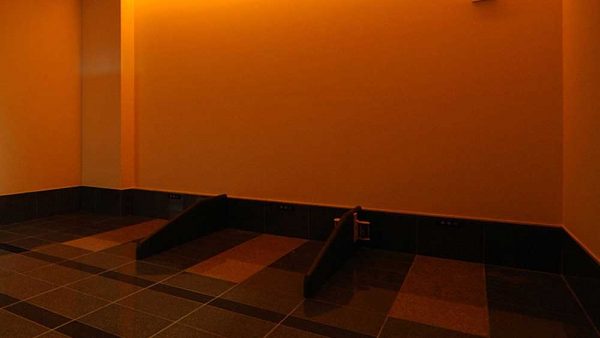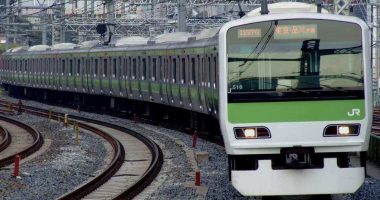At the larger onsen when you first walk out of the changing rooms and into the bathing area you can be faced with an overwhelming choice of baths of all different shapes and sizes. For first-time visitors this can all be a bit confusing and labels and signs in English are few and far between. Here are the baths and features you might have find at the hot springs…
Kake-yu【掛け湯】
Usually the first thing you’ll see when you enter the bathing area. Yu (湯) means hot water and kake (かけ) means put on or throw—so this is the water that you dowse your body with before you enter the baths. Many opt to wash themselves in the showers instead, but in any case you should cleanse your body before you enter the baths.
Shower Area
The bathtubs at the onsen and sento are not for cleaning your body; they are for relaxing and soothing the aches and weariness from a long day. You should cleanse yourself in the shower areas before entering the bathtubs. You will always find a line of showers (sometimes with separators, more often without) when you enter the bathing area. In front of the showers you will have a small basin (for shaving) and a stool. Japanese wash themselves while seated, although you do find standing shower cubicles in some onsen. Just about all onsen provide body wash, shampoo, and conditioner in the shower area.
Rotenburo【露天風呂】
Literally, open-air bath, rotenburo are really what make bathing at the onsen in Japan so special. Most onsen will have a rotenburo, but there are views and then there are views. Hottarakashi Onsen in Yamanashi Prefecture, for example, offers such a spectacular view of Mount Fuji on a clear day that you’ll never want to leave the water.
Jet bath
Same sort of thing as a Jacuzzi—bubbles fire up from different angles at your skin. Fairly common in the onsen, although less so at the more traditional establishments.
Carbonated Bath【二酸化炭素泉】
Ever wanted to bath in warm sparkling water? Well, now you can. The carbonated water is supposed to help with circulation, but the immediate effect is a tingling sensation on your skin.
Nekorobi【寝ころび】
Nekorobi are not baths as such; they are stone slabs over which warm onsen water trickles. You lie supine (usually with a raised stone for a pillow), and relax while looking up at the sky (the constant stream of water keeping your body from getting cold).
Hinoki Bath【檜】
apanese cypress, hinoki cypress or just hinoki is a species of Cypress native to Japan. It is highly resistant to rot and is lemon-scented—the perfect wood from which to make a bathing tub.
Tsubo-yu【つぼ湯】
Tsubo-yu are often found at the onsen (usually outside). They are one-man pot tubs into which hot spring water constantly flows (and overflows). You can either squat down inside or, if you really want to show you’re an onsen lover, lie in with your arms and legs dangling out at the side.
Denki-buro【電気風呂】
This one is a bit more of a rarity. It’s a tub (or an area of a tub) which pulsates with an electrical current. Bathtubs and electricity are not normally two things that go hand-in-hand, but the denki-buro won’t give you a shock—it just produces an intermittent frizzling sensation on the skin like static electricity. If you’re interested, Yumori no Sato has an electric cave in its main open-air bath.
Scented Bathtub
This one is pretty obvious. Some onsen scent the water of bathtubs or put flowers, petals, and even fresh fruit into the water. Not seen so often, but they’re out there.
Silk Bath
A bit like a jet bath or Jacuzzi, but with very fine bubbles that turn the water white and feel like—you guessed it—silk on the skin.
Goemon Pot
A goemon pot is a type of wooden pot tub that gets its name from Ishikawa Goemon, an infamous outlaw in the Edo period who was boiled alive in one for his crimes.
Sauna
Not much explanation needed here, but the sauna at the onsen come in all different forms. The family-orientated onsen will often have televisions fitted with a tiered seating system so that everyone is facing the screen. The more traditional onsen will keep things simple and let you sweat in peace.
Mist Sauna
Dry saunas are typically 80-100°C with a humidity around 10%. Mist saunas, on the other hand, are set at a much lower temperature (around 40°C) but with a humidity closer to 100%. As a result they are less harsh than the typical dry saunas and more often found in the female onsen.
Mizuburo【水風呂】
If the onsen has a sauna, then it will almost always have a mizuburo (“cold water tub”). The temperature is usually around 17-20°C and you are supposed to get in after a stint in the sauna to cool the body down, but remember to wash away the sweat from your body in the shower area or by using the kake-yu before you do so.
Ganbanyoku【岩盤欲】
Called ganbanyoku (岩盤欲) in Japanese, Wikipedia tells me that this originated in Thailand, but in any case it is a popular beauty treatment service whereby users lie down on flat magma stones that are heated to 42-44°C. The heated stones apparently emit far-infrared rays which are supposed to help with metabolism and circulation, while the sweat emitted from your body has detox benefits. Although it is often termed “hot stone bathing” or “hot stone bath” in English, no water is used. Charges for this service are typically in addition to the entrance fee, but places like Heiwajima onsen have a hot stone room free as part of the baths.
